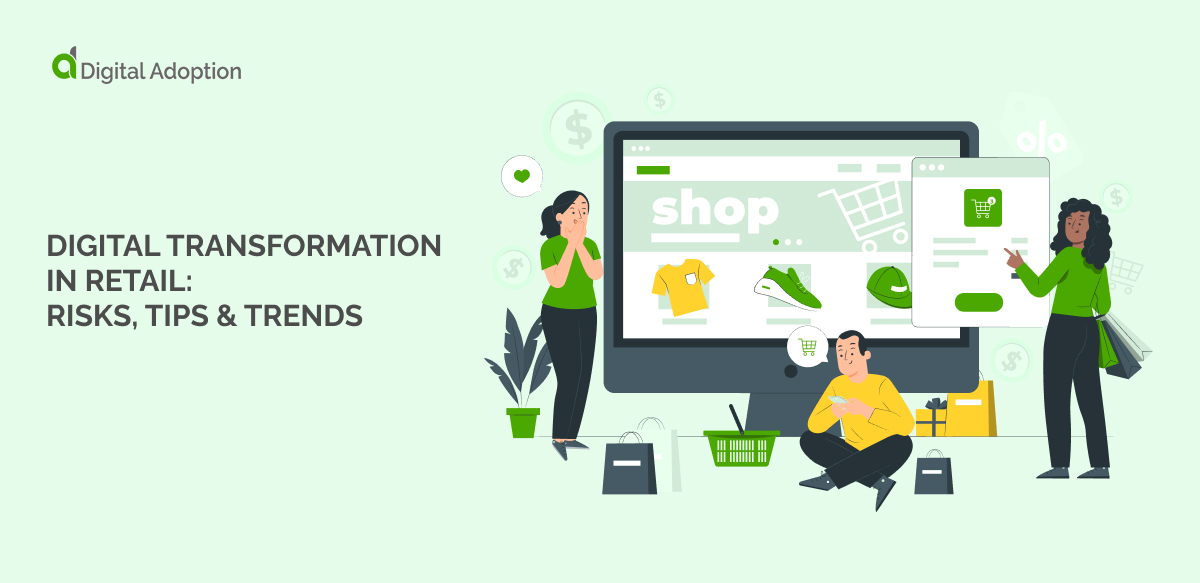Digital transformation in retail is a big deal.
It doesn’t matter if your business is huge or tiny – we all know digital technology is everywhere now. Every day, the average person interacts with the latest technologies many times.
But for retailers, digital transformation goes much deeper than customer experiences.
Check-outs, social media, and payment are just one part of the picture. A good digital transformation connects business processes, customer experiences, and decision-making. And as in any digital adoption in business, it improves business value, planning, and operational costs.
This article will explain how digital transformation can help your retail business. It will explain digital transformation, why it matters, and what it looks like. We will also explain some of the fundamental building blocks of digital transformation.
Many retailers see that future success depends on a successful digital transformation journey.
- What Is Digital Transformation In Retail?
- Why Is Digital Transformation In Retail Important?
- Retail Digital Transformation Trends
- The Building blocks of Digital Transformation in Retail
- Three Ways to Make a Difference in the Retail Industry DX
- Digital Transformation Risks for the Retail Sector
- Digital transformation: Optimizing the retail market
What Is Digital Transformation In Retail?
Most people see digital retail transformation every day of their lives.
If you track a delivery, talk to a customer service chatbot, or receive personalized sales emails – you are looking at a small part of digital transformation.
The customer experience is the starting point. But digital transformation is a vast concept. It’s all about making business decisions with technology. Businesses with good digital transformation initiatives gather data that changes what they do on a daily basis.
In retail, that could mean:
- Store and inventory management: For example, when RFID tags are attached to products, scanners can quickly read and store the information. Retailers get a real-time picture of their stock levels.
- In-store, the use of electronic Shelf Labels (ESLs): These digital displays can be updated remotely, reducing the need for manual updates. Retailers can change prices, promotions, and product information in real-time.
- Workforce planning: With regular scheduling, sickness, and vacations, retailers often face complex staffing patterns. Efficient software takes the pain out of these operations.
Most customers will never think about these areas of the business. However, they experience the benefits. When inventory, discounts, and staffing are up-to-date, consumers are more likely to have a great experience and return in the future.
Behind the scenes, all these systems produce data. Business leaders can use that data to make quick decisions that keep the business moving efficiently. And in time, they can use the data to understand the patterns in consumer behavior.
Why Is Digital Transformation In Retail Important?
In the short term, digital transformation can make your company work better. For example, that might include
- Better customer experience
- Streamlined handling of money
- Transparency in financial transactions
- Up-to-date Inventory management
A digital transformation strategy can ensure your company grows in the long term. To prepare for the future, digital transformation should be a core aspect of any business.
Retail Digital Transformation Trends
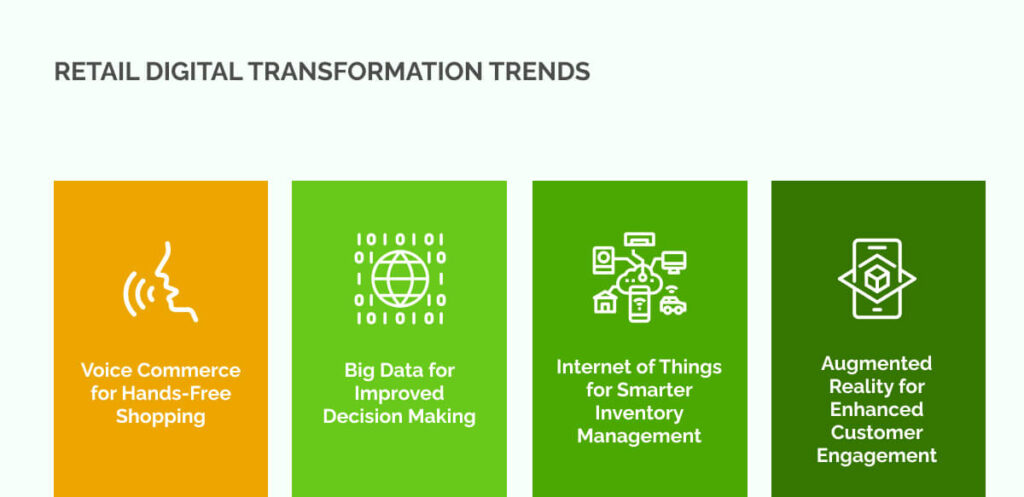
Many aspects of a digital retail business are now familiar. But what’s the future going to look like? We are seeing the start of some exciting developments, including voice commerce, enhanced use of data, augmented reality, and the Internet of Things (IoT).
Voice Commerce for Hands-Free Shopping
“Voice commerce” uses services like Alexa, Google Assistant, or Siri to buy products. Voice-activated buying is very convenient for consumers. People with busy lives can order more laundry detergent or toilet paper without stopping. And people with disabilities will find it much more accessible. As a result, voice commerce could bring in new customers and keep them returning.
Big Data for Improved Decision-Making
Digital technologies are great at collecting data from all areas of a business. Data analytics can get insights into customer behavior, supply chain optimization, fraud detection, and more.
As we go forward, businesses will find more and more ways to gather good data. With that information, they can improve decision-making at every level of the organization.
Internet of Things for Smarter Inventory Management
For retailers, internet of things capabilities is vital to a robust digital infrastructure. Sensors and RFID tags can monitor products at every step of the supply chain and support managers in serving their customers well. The data collected through these systems can go on to create efficiencies in the company’s future.
Augmented Reality for Enhanced Customer Engagement
Augmented Reality and Virtual Reality have an exciting future in apparel, cosmetics, and interior design. Many companies may be scared by new technologies, especially when they must be integrated with a product catalog. A 2023 Forrester blog showed that luxury brands’ digital transformation grows with innovation (as well as convenience). Companies that invest in this technology now will be ahead of the game.
The Building blocks of Digital Transformation in Retail
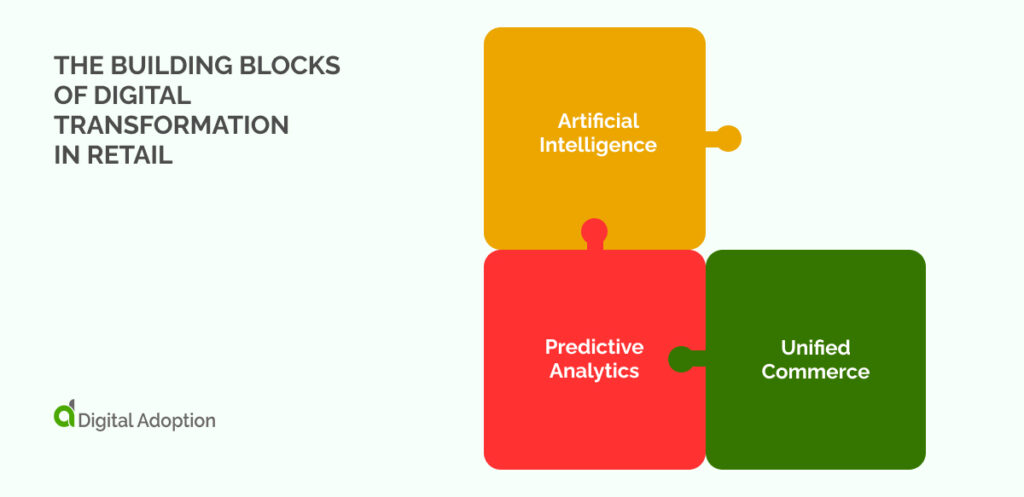
Digital transformation projects are built on decades of careful research. Most business owners don’t need to know the details of all this technology. However, even a small business owner should understand some of the key technologies that operate. In today’s world, digital transformation can feel like magic, but we must have a working knowledge of the background. Three particularly important areas are AI, machine learning, and unified commerce.
Artificial Intelligence
A 2021 report from BCG identified AI as one of the most critical areas for investment in digital transformation in packaged goods. Artificial intelligence can be beneficial for customer experiences. Use cases include voice commerce, personalization, and virtual assistants. Customers now assume that they will engage with a business through AI.
Predictive Analytics
In predictive analytics, your team uses data from the past to make decisions about the future. Retailers can use predictive analytics to forecast future sales, optimize inventory, and meet customer expectations at every step of their journey.
Unified Commerce
“Unified Commerce” aims to integrate all data to provide a seamless and consistent customer experience. With unified commerce, customers can interact with retailers through multiple channels, such as brick-and-mortar stores, e-commerce websites, mobile apps, social media, and more, and have a consistent experience across all.
Three Ways to Make a Difference in the Retail Industry DX
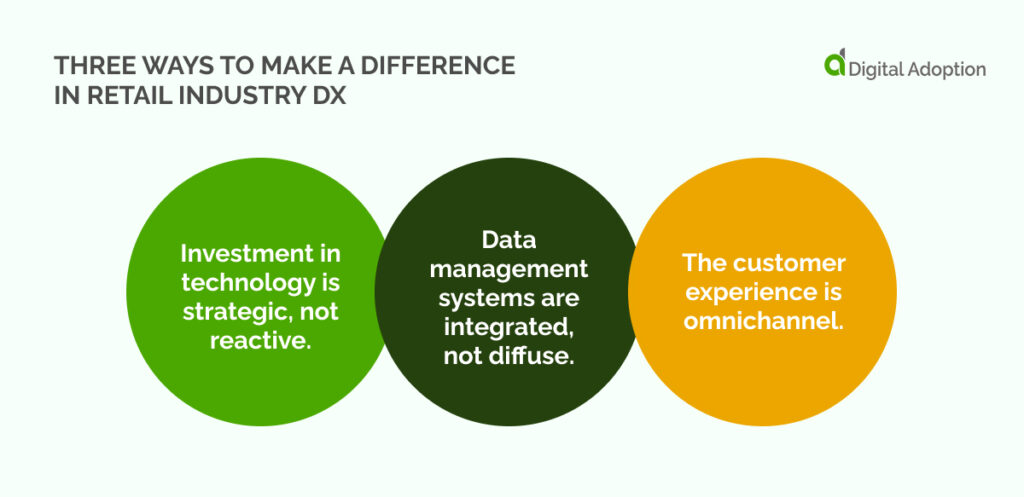
The latest trends in technology can feel very exciting. But a business must have strong digital foundations to get the most from digital transformation. When technology is strategic and integrated, companies use their digital assets far better. We can reduce these principles to the following three areas:
- Investment in technology is strategic, not reactive. Business leaders can’t implement technology at random. They must plan their digital transformation projects and monitor the results. After all, not every piece of hardware or software will be useful. Each retail business must know what works for them to use money effectively.
- Data management systems are integrated, not diffuse. This is one of the most challenging problems for businesses to adapt to. Think about a company without a clear digital transformation strategy. Without direction, different business areas will handle data in whatever way suits them best. However, this means that companies end up with a patchwork of solutions.
Businesses that integrate data management systems help different business units to communicate with each other. For example, an ERP system can provide real-time visibility into inventory levels, customer orders, and financial transactions across the organization. - The customer experience is omnichannel. Data about customers and products can streamline the buyer’s journey. However, if data does not work well between platforms, customers can have a highly negative impression of the company.
Digital Transformation Risks for the Retail Sector
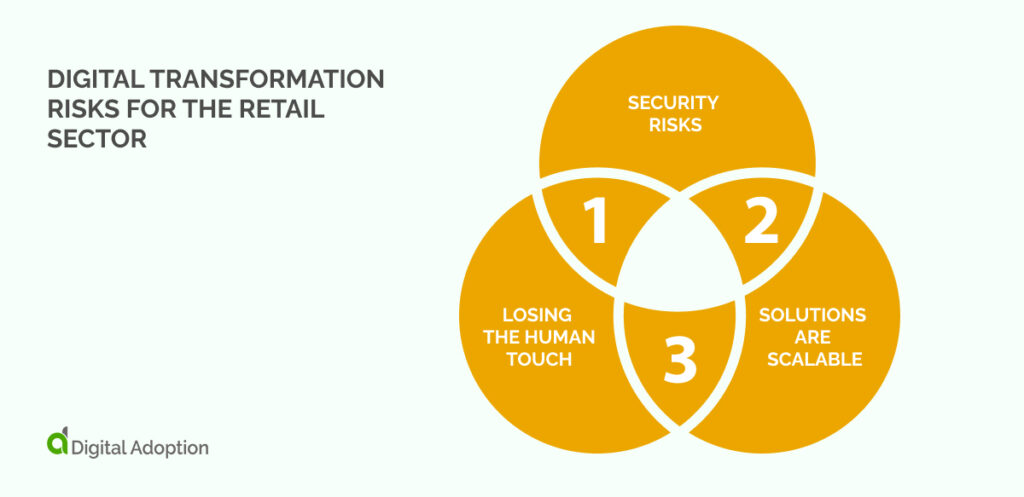
As we’ve seen, digital transformation has many incredible benefits for retailers. But let’s face it. Like any innovation, moving to a digital-first business comes with many risks.
Some customers will worry about losing the human touch in their interactions with the business. That might be especially important for any industry working with elderly or vulnerable people.
Digital transformation does come with security risks. When companies store a lot of data, it could be compromised. Companies should invest in their data security, but there is always a chance that things will go wrong.
In general, digital transformation solutions are scalable. A cloud software package for ten staff will also work for a hundred. However, as the digital transformation project grows, there may be unforeseen issues with the choice of software, the cross-business applications, and the associated costs. Companies really must be strategic if they want to get the most business value from digital implementation projects.
Digital transformation: Optimizing the retail market
Overall, digital transformation is a journey, not a destination. Retailers who want to stay competitive must continuously adapt to new technologies.
So, we are right to get excited about voice commerce, big data analytics, the Internet of Things, and augmented reality.
But you must remember. Digital transformation is not only about implementing new technologies. It’s about strategically using strategically to achieve business goals, improve customer experience, and optimize business processes. So many business areas can benefit, including customer experience, decision-making, and inventory control.
At the deepest level, digital transformations must convert to logical, rational, and up-to-date systems. To succeed in digital transformation, retailers must have a robust digital infrastructure and understand the key technologies driving digital transformation projects.

